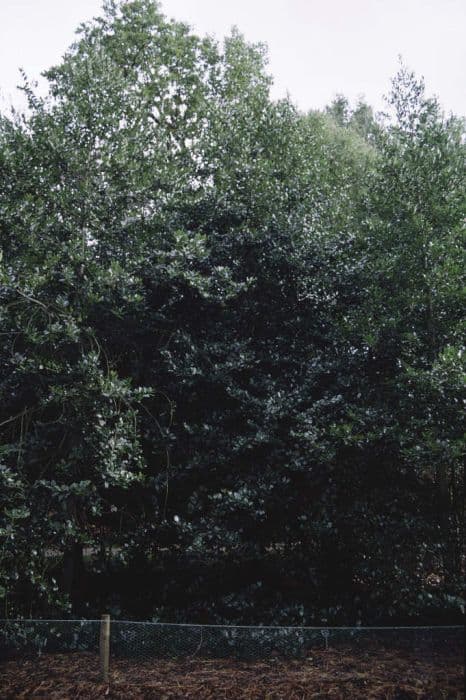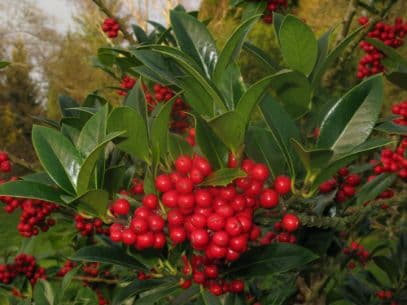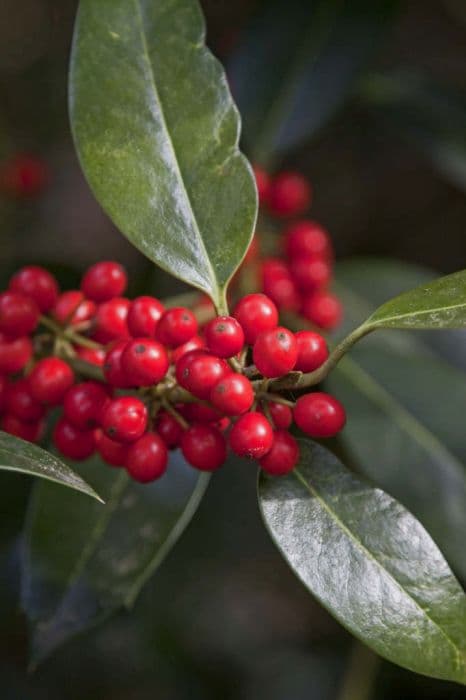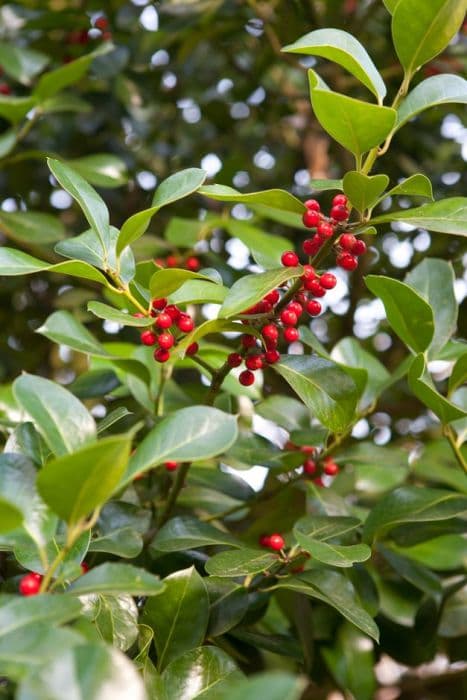Winterberry Ilex verticillata

ABOUT
Ilex verticillata, commonly known as winterberry, is a deciduous holly native to eastern North America. This plant is well known for its distinctive appearance, especially during the fall and winter months when it is most notable. Despite its association with hollies, the winterberry does not have the typical evergreen, spiky leaves. Instead, its foliage consists of simple, alternate leaves with a toothed or serrated margin, adding a fine texture to the plant. The leaves are dark green and have a somewhat glossy appearance in the summer, before turning a yellowish to purplish bronze in the fall. This seasonal color change provides visual interest in garden landscapes. However, what truly sets the winterberry apart and garners much attention are its bright red berries, which persist on the plant throughout the winter after the leaves have fallen. These berries are typically small and densely clustered along the branches, proving to be both a striking ornamental feature as well as an important source of food for birds and other wildlife during the cold months. The winterberry's bark is smooth and gray to brown in color. Its branches tend to form a dense, rounded shrub, which can often appear somewhat leggy or open at the base if not pruned or grown in a thicket with other plants. This plant's distinctive bright berries and seasonal changes in leaf color give it a dynamic role in garden landscapes, providing both aesthetic beauty and ecological benefits.
About this plant
 Names
NamesFamily
Aquifoliaceae.
Synonyms
Winterberry, Black Alder, Coralberry, Fever Bush, Michigan Holly, Canada Holly, Winterberry Holly.
Common names
Ilex bronxensis, Ilex tenuifolia, Prinos verticillatus, Prinos verticillatus f. tenuifolius, Prinos verticillatus var. tenuifolius, Prinos verticillatus var. padifolius.
 Toxicity
ToxicityTo humans
The plant commonly known as Winterberry is considered to be of low toxicity to humans. However, ingestion of its berries in large quantities can lead to symptoms such as nausea, vomiting, diarrhea, and abdominal pain. Although poisoning from Winterberry is not typically fatal, it is still advisable to seek medical attention if ingestion occurs, especially in children, as their smaller body size can make them more susceptible to the toxic effects.
To pets
Winterberry is also toxic to pets, such as dogs and cats. If pets ingest the berries, they may experience gastrointestinal upset, which can include symptoms like vomiting, diarrhea, and abdominal pain. While generally not life-threatening, it is important to keep an eye on pets and prevent them from consuming parts of this plant. In the event that a pet has consumed Winterberry, it is advisable to consult a veterinarian.
 Characteristics
CharacteristicsLife cycle
Perennials
Foliage type
Deciduous
Color of leaves
Green
Flower color
White
Height
3-12 feet (0.9-3.7 meters)
Spread
3-12 feet (0.9-3.7 meters)
Plant type
Shrub
Hardiness zones
3-9
Native area
North America
Benefits
 General Benefits
General Benefits- Landscape Aesthetics: Ilex verticillata, commonly known as Winterberry, adds vibrant color and interest to gardens, especially in the winter when its bright red berries stand out against the landscape.
- Wildlife Habitat: Provides food and shelter for birds and other wildlife. The berries are a crucial food source for birds in winter when other resources are scarce.
- Erosion Control: Its root system stabilizes soil and helps prevent erosion, especially in moist or wet areas.
- Adaptability: Winterberry is adaptable to a wide range of soil conditions, which allows it to thrive in various landscapes and climates.
- Low Maintenance: Once established, it requires minimal care, making it ideal for gardeners who prefer low-maintenance plantings.
- Pollinator Support: Flowers attract bees and other pollinators, which are essential for the ecosystem and for many food crops.
- Education and Research: Winterberry can be used in educational settings to teach about plant biology, ecology, and conservation.
- Cultural Significance: It holds value in certain cultures for its beauty and as a symbol of the holiday season.
- Seasonal Variety: Offers year-round interest — flowers in spring, lush foliage in summer, berries in autumn and winter.
 Medical Properties
Medical Properties- Anti-inflammatory: Ilex verticillata may have properties that help reduce inflammation.
- Diuretic: It has been traditionally used to increase urine production for the purpose of flushing out fluids from the body.
- Fever reducer: There is anecdotal evidence that suggests it may have been used to help reduce fevers.
 Air-purifying Qualities
Air-purifying QualitiesThis plant is not specifically known for air purifying qualities.
 Other Uses
Other Uses- Winterberry, the common name for Ilex verticillata, can be used as a source of food dye; its berries produce a red pigment suitable for coloring foods and textiles.
- The plant's flexible stems have been utilized in basket weaving, offering a natural and sturdy material for crafting.
- Winterberry's vibrant berries serve as an eco-friendly alternative to plastic holiday decorations, providing a festive touch to indoor and outdoor displays.
- In landscaping, winterberry is often used for erosion control due to its dense root system that helps secure soil in place.
- This plant provides habitat enrichment for wildlife gardens, as its structure and berries offer food and shelter for various bird species.
- The winterberry has been incorporated into cultural festivals and ceremonies as a symbol of renewal and hope, especially during winter solstice celebrations.
- The berries of the winterberry can be used to make a natural ink for arts and crafts by crushing them and mixing the juice with a fixative.
- Its bright red berries are sometimes used in photography and painting as a source of inspiration or as a focus for still life compositions.
- As a native plant, winterberry plays an important role in restoration projects aimed at reestablishing indigenous plant populations and supporting biodiversity.
- The branches and boughs of winterberry are popular in floral arrangements and wreath-making, adding a pop of natural color to decorative pieces.
Interesting Facts
 Feng Shui
Feng ShuiThe Winterberry is not used in Feng Shui practice.
 Zodiac Sign Compitability
Zodiac Sign CompitabilityThe Winterberry is not used in astrology practice.
 Plant Symbolism
Plant Symbolism- Protection: Like many hollies, Ilex verticillata is often associated with protection due to its spiny leaves, which historically were thought to ward off negative energies and evil spirits.
- Good Fortune: The bright red berries of the Winterberry holly are symbolic of good luck and prosperity. They bring a splash of color to the landscape during winter months, signifying hope in bleak times.
- Endurance and Survival: As a plant that thrives in challenging conditions and retains its berries through winter, Winterberry holly represents resilience and the ability to endure hardship.
- Renewal: Since Winterberry holly is deciduous and regrows its leaves each spring, it symbolizes rebirth and new beginnings.
 Water
WaterThe Winterberry (Ilex verticillata) prefers consistently moist soil, so water this plant deeply once or twice a week depending on weather conditions. During dry spells or intense heat, increase watering frequency to maintain soil moisture, but avoid waterlogging. During the growing season, a good rule is to provide the Winterberry with about 1 to 1.5 gallons of water each week, though this can be adjusted for rainfall and soil type. In the winter, reduce watering since the plant will be dormant and requires less moisture. Make sure to water the soil directly at the base of the plant to ensure the roots receive adequate hydration.
 Light
LightWinterberry thrives in full sun to part shade conditions. For best results, plant the Winterberry in a location where it receives at least 4 hours of direct sunlight daily. However, it can also perform well in areas with dappled sunlight or places that get morning sun and afternoon shade. Avoid deeply shaded areas which can reduce bloom and berry production.
 Temperature
TemperatureWinterberry can tolerate a wide range of temperatures, making it suitable for various climates. Ideally, it grows best in temperatures between 50°F and 70°F. The plant is hardy and can withstand temperatures as low as -40°F and as high as 90°F, though extreme conditions for prolonged periods may stress the plant. Winterberry is well-suited for USDA hardiness zones 3 through 9.
 Pruning
PruningPrune Winterberry to maintain shape and remove any dead or diseased wood. The best time for pruning is late winter or early spring, before new growth starts. Pruning encourages healthy growth and better berry production. Usually, it's enough to prune every couple of years, unless shaping is required more frequently. When pruning, make cuttings just above a pair of buds to stimulate new growth in the desired direction.
 Cleaning
CleaningAs needed
 Soil
SoilWinterberry prefers acidic soil with a pH of 3.5 to 6.0. For optimal growth, mix peat moss, pine bark, and perlite in equal parts to ensure good drainage and maintain acidity. Avoid alkaline soil to prevent yellowing of leaves.
 Repotting
RepottingWinterberry, being a slow-growing shrub, does not require frequent repotting. It is typically repotted every 3-5 years to refresh the soil and to accommodate root growth. However, it can often be left undisturbed for longer periods if it is thriving.
 Humidity & Misting
Humidity & MistingWinterberry thrives in average outdoor humidity levels but can tolerate a range. It does not have high humidity requirements and can grow well in both humid and drier conditions typical of temperate climates.
 Suitable locations
Suitable locationsIndoor
Place winterberry in acidic soil, direct sunlight, and water thoroughly.
Outdoor
Plant in acidic, moist soil; full sun to part shade; and mulch well.
Hardiness zone
3-9 USDA
 Life cycle
Life cycleIlex verticillata, commonly known as winterberry, begins its life cycle as a seed, which when conditions are suitable, germinates in the soil. The seedling emerges and develops into a juvenile plant, characterized by rapid growth as it establishes a strong root system and begins to grow leaves. As it matures into an adult plant, it displays a greater number of leaves, branches, and begins to flower, typically producing small white to greenish-white flowers that are pollinated by insects. After pollination, the plant forms bright red berries, which are especially prominent in the fall and winter months after the leaves have fallen, and serve to attract birds that eat them and disperse the seeds. The plant enters a period of dormancy in the winter, reducing its metabolic activity to survive the cold. This perennial shrub may live for many years, repeating the flowering and fruiting cycle annually while continuing to grow and spread.
 Propogation
PropogationPropogation time
Summer to early fall
The most popular method of propagating the Winterberry (Ilex verticillata) is by softwood cuttings, typically done in late spring or early summer when new growth is still tender and green. To propagate by this method, a cutting about 4 to 6 inches (10 to 15 centimeters) long is taken from the current year's growth. The lower leaves are removed, and the base of the cutting is dipped in a rooting hormone to encourage root development. The prepared cutting is then placed in well-draining soil and kept moist until roots have developed, which could take a few weeks. During this time, the cuttings should be kept in indirect light and at a consistent temperature to promote rooting. After successfully rooted, the new plants can be gradually acclimated to outdoor conditions and eventually transplanted to their permanent location in the garden.









